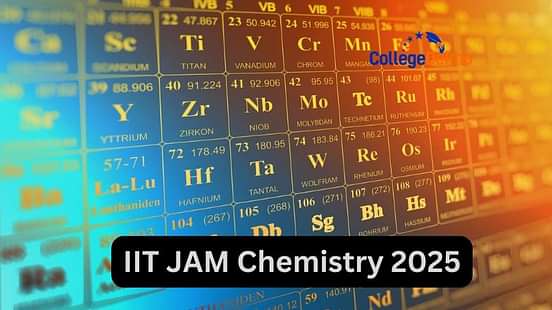IIT JAM Chemistry (CH) 2025 is set to be held on February 2, 2025 from 9:30 AM to 12:30 PM (Forenoon Session). Students can check all the latest JAM exam information, like important dates, topic-wise syllabus, previous year papers, topic-wise weightage, etc., here.

IIT JAM Chemistry(CY) 2025 is set to be held on February 2, 2025 from 9:30 AM to 12:30 PM (Forenoon Session) across various exam centres in India. Students qualifying the entrance can open prospects for MSc in Chemistry programme from any top-rated IIT. IIT JAM 2025 Chemistry syllabus must be religiously followed to enhance chances of securing a good rank. As per the latest updates, the syllabus for chemistry underwent a major update that concerns the addition of a new section on basic mathematical concepts. Besides, covering chapters on organic, inorganic and physical chemistry, now candidates require to prepare 10+2 level mathematics.
Read this article to explore more about IIT JAM Chemistry 2025 exam date, syllabus, important topics, best books, and more.
Also Check:
IIT JAM 2025 Preparation Strategy, Tips, Study Plan, Timetable
Key Details on IIT JAM Chemistry Exam 2025
Find out some key details on IIT JAM Chemistry exam 2025 for a better understanding of dates, patterns, and other information.
Particulars | Details |
|---|---|
Exam Name | IIT JAM |
Conducting Body | IIT Delhi |
Exam Level | National |
Course Offerings | MSc Chemsitry or Integarted PhD |
Mode of Exam | Online |
Duration | 3 Hours |
Number of Sections in JAM Chemistry | Section A: MCQ Section B: MSQ Section C: NAT |
Total marks | 100 |
Application Status | Concluded |
IIT JAM Chemistry Exam Date | February 2, 2025 (Sunday) |
IIT JAM 2025 Important Events with Dates
Explore below the important IIT JAM 2025 events and their dates:
JAM 2025 Events | Schedule |
|---|---|
Commencement of online application | September 3, 2024 |
Last date to register | October 18, 2024 |
Last date to change exam centre, category or test paper | November 18, 2024 |
Uploading of valid OBC/EWS certificate | November 20, 2024 |
Conformation of compensatory time or scribe assistance | December 30, 2024 |
Publication of IIT JAM admit cards | January 6, 2025 |
Exam date | February 2, 2025 |
Result declaration | March 19, 2025 |
Availability of scorecards for download | March 25, 2025 |
Admission opens | April 2, 2025 |
Also Read: IIT JAM Exam Pattern 2025
IIT JAM Chemistry 2025 Syllabus
Candidates can check out the list of total chapters in IIT JAM Chemistry 2025 Syllabus which is divided into 3 parts Physical Chemistry, Organic Chemistry, and Inorganic Chemistry.
IIT JAM Chemistry 2025 Syllabus: Physical Chemistry
Topics | Sub-Topics |
|---|---|
Atomic and Molecular Structure | Planck's black body radiation, Photoelectric effect, Bohr's theory, de Broglie postulate, Heisenberg's Uncertainty Principle; Schrödinger's wave equation (including mathematical treatment), postulates of quantum mechanics, normalized and orthogonal wave functions, its complex conjugate (idea of complex numbers) and significance of Ñ°2; Operators; Particle in one-dimension box, radial and angular wave functions for hydrogen atom, radial probability distribution; Finding maxima of distribution functions (idea of maxima and minima), energy spectrum of hydrogen atom; Shapes of s, p, d and f orbitals; Pauli's Exclusion Principle; Hund's rule of maximum multiplicity. |
Gaseous State | Kinetic molecular model of a gas: collision frequency; collision diameter; mean free path and viscosity of gases; Maxwell-Boltzmann distribution: molecular velocities, law of equipartition of energy, molecular basis of heat capacities; Ideal gases, and deviations from ideal gas behaviour, van der Waals equation of state; critical state, law of corresponding states. |
Liquid State | Physical properties of Liquid, vapor pressure, surface tension and co-efficient of viscosity and their applications; effect of concentration of solutes on surface tension and viscosity; effect of temperature on viscosity of liquids. |
Solid State | Unit Cells, Miller indices, crystal systems and Bravais Lattices, elementary applications of vectors to crystal systems; X-ray diffraction, Bragg's Law, Structure of NaCl, CsCl, and KCl, diamond, and graphite; Close packing in metals and metal compounds, semiconductors, insulators; Defects in crystals, lattice energy; isomorphism; heat capacity of solids. |
Chemical Thermodynamics | Mathematical treatment: Exact and in-exact differentials, partial derivatives, Euler's reciprocity, cyclic rule; Reversible and irreversible processes; Laws of thermodynamics, thermochemistry, thermodynamic functions, such as enthalpy, entropy, and Gibbs free energy, their properties and applications; Partial molar quantities, dependence of thermodynamic parameters on composition, Gibbs Duhem equation, chemical potential and its applications. |
Chemical and Phase Equilibria | Law of mass action; Kp, Kc, Kx and Kn; Effect of temperature on K; Le-Chatelier principle; Ionic equilibria in solutions; pH and buffer solutions; Salt hydrolysis; Solubility and solubility product; Acid – base titration curves; Indicators; Dilute solutions; Raoult's and Henry's Laws and their applications; Colligative properties; Gibbs phase rule; Phase equilibria; single and two-component phase diagrams. |
Electrochemistry | Conductivity, equivalent and molar conductivity and their properties; Kohlrausch law; DebyeHückelOnsager equation; Ionic velocities, mobilities, transference numbers; Applications of conductance measurement; Quantitative aspects of Faraday's laws of electrolysis, applications of electrolysis in metallurgy and industry; Electromotive force of a cell, Nernst equation; Standard electrode potential, Electrochemical series; Concentration cells with and without transference; Applications of EMF measurements including potentiometric titrations. |
Chemical Kinetics | Order and molecularity of a reaction, differential and integrated form of rate expressions - basic ideas of integration and differentiation; Kinetics of opposing, parallel, and consecutive reactions; Steady state approximation in reaction mechanisms; Chain reactions; Uni-molecular reaction (Lindemann mechanism); Temperature dependence of reaction rates, Arrhenius equation; activation energy; Collision theory of reaction rates; Types of catalysts, specificity and selectivity, mechanisms of catalyzed reactions at solid surfaces; Enzyme catalysis (Michaelis-Menten mechanism, Double reciprocal plot), Acid-base catalysis. |
Adsorption | Gibbs adsorption equation; adsorption isotherm; types of adsorption; surface area of adsorbents; surface films on liquids |
Spectroscopy | Beer-Lambert's law; fundamental concepts of rotational, vibrational, electronic and magnetic resonance spectroscopy. |
IIT JAM Chemistry 2025 Syllabus: Organic Chemistry
Topics | Sub-Topics |
|---|---|
Basic Concepts in Organic Chemistry and Stereochemistry | Electronic effects (resonance, inductive, hyperconjugation) and steric effects and its applications (acid/base property); optical isomerism in compounds with and without any stereocenters (allenes, biphenyls); conformation of acyclic systems (substituted ethane/n-propane/n-butane) and cyclic systems, substituted cyclohexanes, and polycyclic (cis and trans decalins) systems. |
Organic Reaction Mechanism and Synthetic Applications | Chemistry of reactive intermediates (carbocations, carbanions, free radicals, carbenes, nitrenes, benzynes); nucleophilic substitution, elimination reactions and mechanisms; Hofmann-Curtius-Lossen rearrangement, Wolff rearrangement, Simmons-Smith reaction, Reimer-Tiemann reaction, Michael reaction, Darzens reaction, Wittig reaction and McMurry reaction; Pinacolpinacolone, Favorskii, benzilic acid rearrangement, Baeyer-Villeger reaction; oxidation and reduction reactions in organic chemistry; Organometallic reagents in organic synthesis (Grignard, organolithium , organocopper and organozinc (Reformatsky only); Diels-Alder, electrocyclic and sigmatropic reactions; functional group inter-conversions and structural problems using chemical reactions. |
Qualitative Organic Analysis | Identification of functional groups by chemical tests; elementary UV, IR and 1H NMR spectroscopic techniques as tools for structural elucidation of simple organic molecules. |
Natural Products Chemistry | Chemistry of alkaloids, steroids, terpenes, carbohydrates, amino acids, peptides and nucleic acids. |
Aromatic and Heterocyclic Chemistry | Monocyclic, bicyclic and tricyclic aromatic hydrocarbons, and monocyclic compounds with one hetero atom: synthesis, reactivity and properties, aromaticity; Electrophilic and nucleophilic aromatic substitution reactions |
IIT JAM Chemistry 2025 Syllabus: Inorganic Chemistry
Topics | Sub-Topics |
|---|---|
Periodic Table | Periodic classification of elements, Aufbau's principle, periodicity; Variations of orbital energy, effective nuclear charge, atomic, covalent, and ionic radii, ionization enthalpy, electron gain enthalpy, and electronegativity with atomic number, electronic configuration of diatomic molecules (first and second row elements). |
Extractions of Metals | General methods of isolation and purification of elements; Principles and applications of Ellingham diagram. |
Chemical Bonding and shapes of molecules | lonic bond: Packing of ions in crystals, radius ratio rule, Born-Landé equation, Kapustinskii expression, Madelung constant, Born-Haber cycle, solvation energy, polarizing power and polarizability; Fajan's rules; Covalent bond: Lewis structure, valence bond theory. Hybridization, molecular orbital theory, molecular orbital diagrams of diatomic and simple polyatomic molecules and ions; Multiple bonding |
Main Group Elements (s and p blocks) | Reactions of alkali and alkaline earth metals with oxygen, hydrogen and water; Alkali and alkaline earth metals in liquid ammonia; Gradation in properties of main group element in a group; Inert pair effect; Synthesis, structure and properties of diborane, ammonia, silane, phosphine and hydrogen sulphide; Allotropes of carbon; Oxides of nitrogen, phosphorus and sulphur; Oxoacids of phosphorus, sulphur and chlorine; Halides of silicon and phosphorus; Synthesis and properties of borazine, silicone and phosphazene; Synthesis and reactions of xenon fluorides. |
Transition Metals (d block) | Characteristics of d-block elements; oxide, hydroxide and salts of first row metals; coordination complexes: structure, isomerism, reaction mechanism and electronic spectra; VB, MO and crystal field theoretical approaches for structure, color and magnetic properties of metal complexes; Organometallic compounds with metal-ligand single and multiple bonds (such as metal carbonyls, metal nitrosyls and metallocenes); Homogenous catalysis involving Wilkinson's catalyst. |
Bioinorganic Chemistry | Essentials and trace elements of life; basic reactions in the biological systems and the role of metal ions, especially Fe2+, and Zn2+; structure and function of myoglobin, hemoglobin and carbonic anhydrase. |
Instrumental Methods of Analysis | Basic principles; instrumentations and simple applications of conductometry, potentiometry and UV-vis spectrophotometry; analyses of water, air and soil samples. |
Analytical Chemistry | Principles of qualitative and quantitative analysis; Acid-base, oxidation-reduction, and complexometric titrations using EDTA; Precipitation reactions; use and types of indicators; Use of organic reagents in inorganic analysis; Radioactivity, nuclear reactions, applications of isotopes mathematical treatment in error analysis, elementary statistics,cs and probability theory. |
IIT JAM Chemistry Past Question Papers
In today's highly competitive world, every student has the goal to do well academically to get admission in the top colleges and universities through entrance exams. One of the most common ways to understand the exam/test pattern is to solve as many previous year's question papers as possible. IIT JAM previous year question papers not only help a student become familiar with the exam pattern, but they also help a student gain confidence in a subject which makes it one of the most effective ways to prepare for an exam.
Students can check out the IIT JAM Chemistry previous year question papers from 2016-2023 in the link provided below:
Previous Year Question Papers | Answer Key |
|---|---|
IIT JAM Chemistry 2025 Topic-wise Weightage
Candidates can check out the IIT JAM Chemistry 2025 topic-wise weightage in the table provided below. With this, you can get an overview of which topic is more important and can make a schedule according to it.
Topics | Syllabus | Weightage |
|---|---|---|
Physical Chemistry | Chemical Thermodynamics | 6 |
Chemical Kinetics | 5 | |
Gaseous State | 2 | |
Liquid State | 2 | |
Solid State | 2 | |
Adsorption | 4 | |
Spectroscopy | 4 | |
Electrochemistry | 5 | |
Atomic and Molecular Structure | 4 | |
Organic Chemistry | Basic Concept of Organic Chemistry and Stereochemistry | 11 |
Organic Reaction Mechanism & Synthetic Application | 10 | |
Qualitative Organic Analysis /Spectroscopy | 5 | |
Natural Products Chemistry | 5 | |
Inorganic Chemistry | Transition metals (d-block) | 6 |
Chemical Bonding and Shapes of Compounds | 6 | |
Analytical Chemistry | 5 | |
Periodic Table | 4 | |
Extractions of Metals | 4 | |
Analytical Chemistry | 2 | |
Instrumental Methods of Analysis | 2 | |
Bioinorganic Chemistry | 2 | |
Main Group Elements (s and p blocks) | 4 |
Also Read: How to Prepare for IIT JAM without Coaching?
Recommended Books to Prepare for IIT JAM Chemistry 2025
If you want to prepare well for IIT JAM Chemistry 2025, refer to the below mentioned books and strengthen your conceptual understanding.
IIT JAM Chemistry Book Name | Author |
|---|---|
Advanced Organic Chemistry | Francis A Carey and Ricahrd J Sundberg |
Organic Chemistry | Jonathan Clayden |
Vogel’s Qualitative Inorganic Analysis | G Svehla |
Physical Chemistry | Keith J Laidler |
Inorganic Chemistry | JD Lee |
Prepare effective study goals and revision plans to fetch maximum marks in IIT JAM Chemistry 2025. Regularly practice previous year papers and take mock tests for better results. Best of luck!
Related Links:
| Importance of Revision in IIT JAM Preparation | Balancing College and IIT JAM Preparation 2025 |
|---|---|
| How to Prepare for IIT JAM Physics Without Coaching | List of IIT JAM Exam Centres Under IIT Delhi |
For more information and the latest updates on IIT JAM 2025 stay tuned with CollegeDekho.
Are you feeling lost and unsure about what career path to take after completing 12th standard?
Say goodbye to confusion and hello to a bright future!

Was this article helpful?





















Similar Articles
List of Colleges Accepting IIT JAM Score 2026
CSIR NET OBC Category Cutoff December 2025
CSIR NET ST Category Cutoff December 2025
CSIR NET Physical Sciences Exam Analysis December 2025 (OUT): Difficulty Level of Question Paper, Expected Good Score
CSIR NET Mathematical Sciences Exam Analysis December 2025 (OUT): Difficulty Level, Expected Good Score, Question Paper Review
CSIR NET Chemical Sciences Exam Analysis December 2025 (OUT): Question Paper Difficulty Level, Expected Safe Score